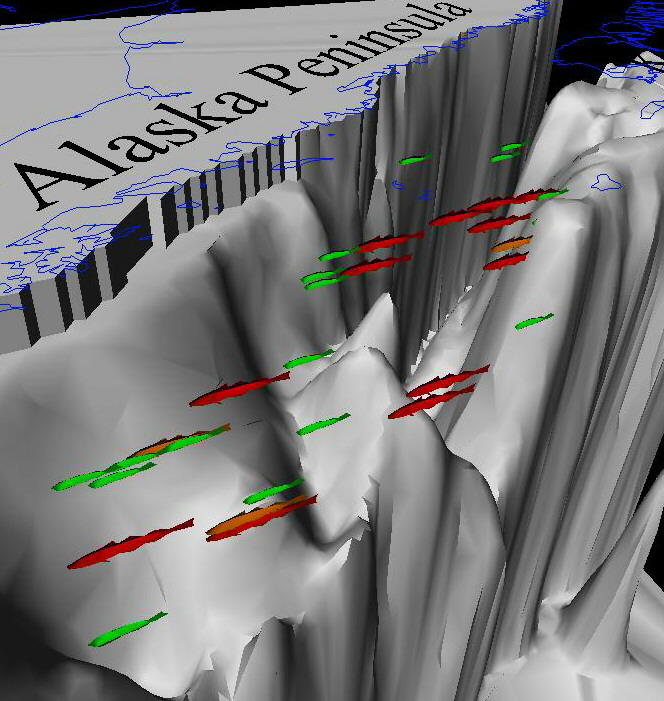For more information on this and related models see:

We have produced 4D representations of some of our indiviual-based fish (pollock) model results for various years, using the Virtual Reality Modeling Language (VRML). These animated worlds *should* run on most PC and Mac web browsers (as most have a VRML viewer installed by default). In the above sample frame Kodiak Island is on the right and Alaska is to the left; we are looking northeast into Shelikof Strait from a viewpoint approximately 300 km offshore and 2 km elevation above sea level. Fish are represented by shapes and colors according to life stage (blue for eggs, yellow for yolk-sac larvae, green for feeding larvae, red for juveniles), and seafloor bathymetry is rendered as a grey surface. The animation runs from March through September, 1987. Eggs are spawned at depth in the strait, move vertically according to life stage, and are advected (both horizontally and vertically) by the currents. Many fish are trapped temporarily in mesoscale eddies, as they advect to the southwest. Click on the above frame to open this world.
VRML worlds require a browser plug-in to view. If your browser doesn't have one (or you just need advice on how to use the one you have), we recommend Cosmo Player.
Here are some other representative fish worlds (simple spheres in black and white) for 1978, 1987, 1988, 1991, and 1994
Also check out our animations
of salinity fields for these years, which highlight eddies in this
region.
Sample FOCI Movies |
| Pollock Movement
Click the image to the right to view a quick sample movie of our individual-based biophysical modeling for FOCI. The moving black dots are representative fish (walleye pollock, Theragra chalcogramma), superimposed on the evolving salinity field for 1989 near Kodiak Island, Alaska. We performed these simulations on the CRAY Y-MP at the Arctic Region Supercomputing Center . |
![[Pollock Movie]](http://www.pmel.noaa.gov/~hermann/images/pollock-260.gif) |
| Pollock Size
Another movie of pollock size for 1987 illustrates positions of fish after hatching, with length of individuals (in mm) coded by color. Note how some fish get entrained in eddy features, which limit their dispersion. |
![[Another Pollock Movie]](http://www.pmel.noaa.gov/~hermann/images/wts-130.gif) |
|
FOCI Project Office |